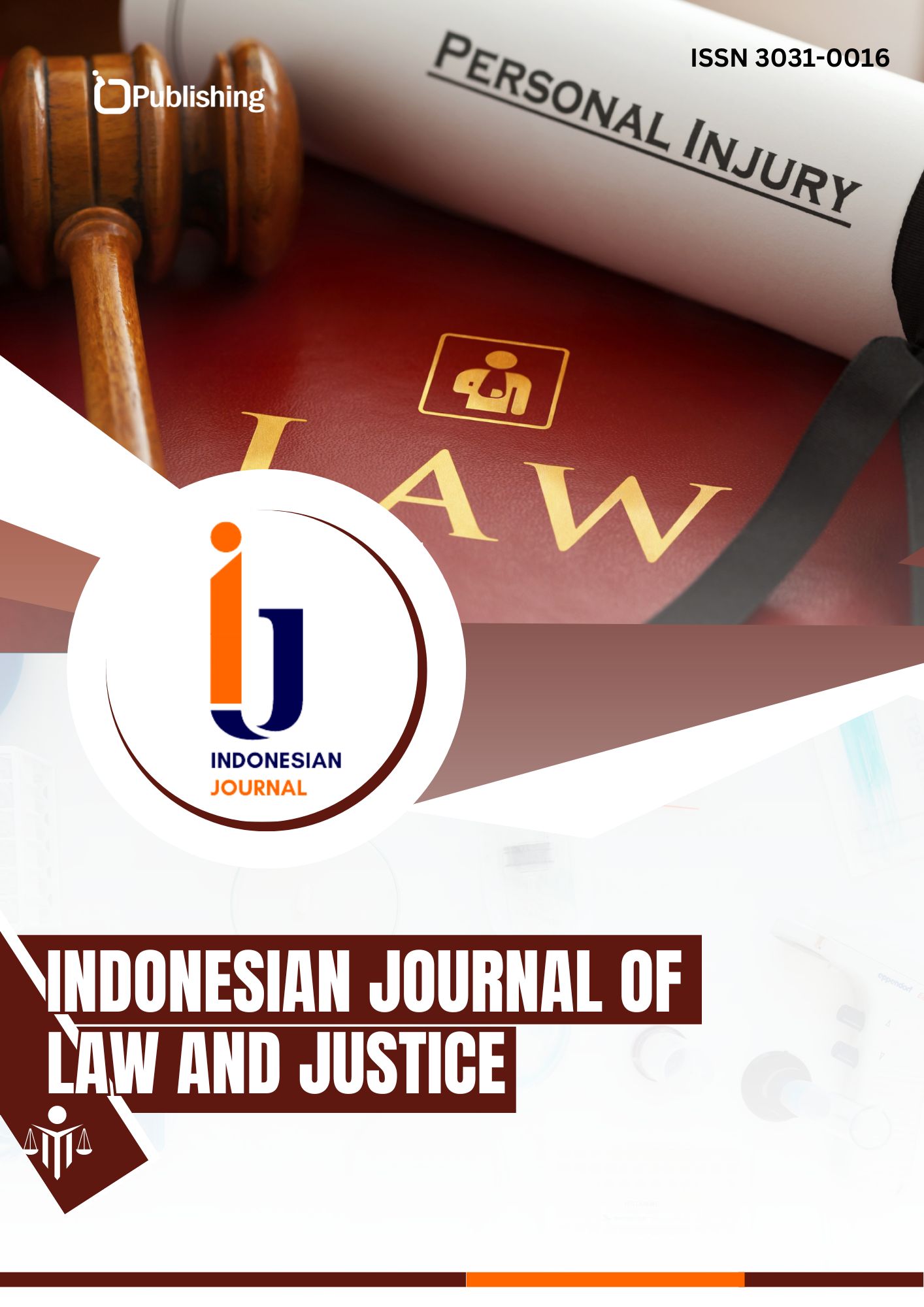Criminal Provisions For Perpetrators Who Commit Criminal Acts of Copulation And Lewd Acts Against Minors
DOI:
https://doi.org/10.47134/ijlj.v1i4.2345Keywords:
Criminal acts, Copulation, Lewd Acts, MinorsAbstract
The frequency of these crimes, one of which is the unlawful act of sexual abuse, which encompasses both fornication and copulation, demonstrates the current high rate of crimes against children. Children and the future of the nation are seriously and dangerously at stake from this. Sexual activity is a crime that seriously damages society, it is taken very seriously, and it makes people feel uneasy since it incites a dread of crime. Data collection, processing, presentation, and analysis related to an event constitute the process of research. to acquire a study outcome that is responsible for science. Normative juridical research is the kind that is employed. Articles 81 and 82 of Law Number 35 of 2014 concerning Amendments to Law Number 23 of 2002 concerning Child Protection discuss the legal provisions for child molestation against children.
References
Adami, C. (2011). Pelajaran Hukum Pidana. Raja Grafindo Persada.
Calzada, A. B. S. D. La. (2019). Sexist street harassment: What kind of answer can the penal law provide? Onati Socio-Legal Series, 9(6), 983–1000. https://doi.org/10.35295/osls.iisl/0000-0000-0000-1080 DOI: https://doi.org/10.35295/osls.iisl/0000-0000-0000-1080
Clemente, M. (2019). Institutional Violence against users of the family law courts and the Legal harassment scale. Frontiers in Psychology, 10. https://doi.org/10.3389/fpsyg.2019.00001 DOI: https://doi.org/10.3389/fpsyg.2019.00001
Dinar, S. A. (2021). Penegakan Hukum Tindak Pidana Pencabulan Terhadap Anak Dibawah Umur Menurut Uu No. 35 Tahun 2014 Tentang Perubahan Atas Uu No. 23 Tahun 2002 Tentang Perlindungan Anak. Sol Justicia, 4(1), 77–90. https://doi.org/10.54816/sj.v4i1.353 DOI: https://doi.org/10.54816/sj.v4i1.353
DM, A. A., & Risma, A. (2022). Penerapan Sanksi Pidana Terhadap Persetubuhan Yang Dilakukan Oleh Anak. Journal of Lex Theory (JLT), 1(2), 297–313. DOI: https://doi.org/10.52103/jlt.v1i2.312
Evans, A. E. (2022). ‘Wasn’t This Already Considered Sexual Harassment?’: Exploring the Confusion Around the Law Mandating Consent to Receive a Nude Sext Message. American Journal of Sexuality Education, 17(3), 343–367. https://doi.org/10.1080/15546128.2021.2025181 DOI: https://doi.org/10.1080/15546128.2021.2025181
Herman, Handrawan, Haris, O. K., Hidayat, S., Zahrowati, & Ahsyam, A. (2023). Batasan Kekerasan Seksual Secara Verbal dalam RKUHP dan Undang-Undang TPKS. Halu Oleo Legal Research, 5(1), 13–30. https://doi.org/https://doi.org/10.33772/holresch.v5i1.216
Hitaminah, K., & Zainal, M. (2022). Studi Komparasi Dan Analisis Terhadap Tindak Pidana Kesusilaan Zina, Pemerkosaan Dan LGBT Dalam Perspektif KUHP Dan RKUHP 2015. Justness: Jurnal Hukum Politik Dan Agama, 1(1), 84–112. https://doi.org/10.61974/justness.v1i1.4 DOI: https://doi.org/10.61974/justness.v1i1.4
Istiklal. (2021). Pertanggungjawaban Pidana Terhadap Terdakwa Tindak Pidana Perzinaan. Unes Journal Of Swara Justisia, 5(3), 250–258. https://doi.org/https://doi.org/10.31933/ujsj.v5i3.221 DOI: https://doi.org/10.31933/ujsj.v5i3.222
Kanter, E., & Sianturi, S. R. (2005). Asas-Asas Hukum Pidana dan Penerapannya di Indonesia. Alumni Ahaem-Petehaem.
Lamintang, P. A. F. (2009). Delik-Delik Kejahatan Melanggar Norma Kesusilaan dan Norma Kepatutan. Sinar Grafika.
Lamintang, P. A. F., & Samosir, C. D. (2014). Dasar-Dasar Hukum Pidana Indonesia. PT. Citra Aditya Bakti.
Lubis, M. A., & Sinaga, L. V. (2020). Tindak Pidana Eksploitasi Seksual (Perkosaan) Oleh Orang Tua Tiri Terhadap Anak Dibawah Umur (Studi Putusan PN Medan No. 1599/PID. B/2007/PN Mdn). JURNAL RECTUM: Tinjauan Yuridis Penanganan Tindak Pidana, 2(2), 92. https://doi.org/10.46930/jurnalrectum.v2i2.638 DOI: https://doi.org/10.46930/jurnalrectum.v2i2.638
Mamudji, S. S., & Mamudji, S. (2011). Penelitian Hukum Normatif Suatu Tinjauan Singkat. PT RajaGrafindo Persada.
Marzuki, P. M. (2017). Penelitian Hukum. Kencana.
McBride, B. (2022). Protection or police harassment? Impacts of punitive policing, discrimination, and racial profiling under end-demand laws among im/migrant sex workers in Metro Vancouver. SSM - Qualitative Research in Health, 2. https://doi.org/10.1016/j.ssmqr.2022.100048 DOI: https://doi.org/10.1016/j.ssmqr.2022.100048
Moreira, T. C. (2019). Sexual harassment and mobbing: Recent amendments in the Portuguese law. European Labour Law Journal, 10(2), 163–167. https://doi.org/10.1177/2031952519850585 DOI: https://doi.org/10.1177/2031952519850585
O’Connell, K. (2019). Can Law Address Intersectional Sexual Harassment? The Case of Claimants with Personality Disorders. Laws, 8(4). https://doi.org/10.3390/laws8040034 DOI: https://doi.org/10.3390/laws8040034
Park, S. (2021). Workplace Harassment in South Korea: Evaluation and Improvement Measures for the Workplace Anti-bullying Law. Asian Perspectives on Workplace Bullying and Harassment, 277–304. https://doi.org/10.1007/978-981-16-2362-2_10 DOI: https://doi.org/10.1007/978-981-16-2362-2_10
Piñeiro, L. C. (2020). Sexual harassment and women seafarers: The role of laws and policies to ensure occupational safety & health. Marine Policy, 117. https://doi.org/10.1016/j.marpol.2020.103938 DOI: https://doi.org/10.1016/j.marpol.2020.103938
Prasetyo, T. (2011). Hukum Pidana. Rajawali Pers.
Raub, A. (2021). Ending sexual harassment at work: Creating a baseline on laws in 193 countries. Human Rights Quarterly, 43(2), 378–393. https://doi.org/10.1353/hrq.2021.0024 DOI: https://doi.org/10.1353/hrq.2021.0024
Shakthi, S. (2020). The law, the market, the gendered subject: workplace sexual harassment in Chennai’s information technology industry. Gender, Place and Culture, 27(1), 34–51. https://doi.org/10.1080/0966369X.2019.1608912 DOI: https://doi.org/10.1080/0966369X.2019.1608912
Shi, E. (2020). Addressing sexual harassment law’s inadequacies in altering behaviour and preventing harm: A structural approach. University of New South Wales Law Journal, 43(1), 155–190. DOI: https://doi.org/10.53637/SGGR6603
Sihotang, P. H. (2020a). Penyelesaian Tindak Pidana Ringan Menurut Peraturan Kapolri Dalam Mewujudkan Restorative Justice (Studi Di Polresta Deli Serdang). Iuris Studia: Jurnal Kajian Hukum, 1(6), 107–120. https://doi.org/10.55357/is.v1i2.37 DOI: https://doi.org/10.55357/is.v1i2.37
Sihotang, P. H. (2020b). Penyelesaian Tindak Pidana Ringan Menurut Peraturan Kapolri Dalam Mewujudkan Restorative Justice (Studi Di Polresta Deli Serdang). Iuris Studia: Jurnal Kajian Hukum, 1(6), 107–120. https://doi.org/10.55357/is.v1i2.37 DOI: https://doi.org/10.55357/is.v1i2.37
Sindabuke, E., Lubis, E., & Solihin, N. (2022). Optimalisasi Penegakan Hukum Terhadap Pelaku Pencabulan Anak Dalam Perspektif Kepastian Hukum (Studi Putusan Nomor 3/Pid.Sus-Anak/2020/Pn.Bdg). Veritas, 8(2), 40–58. https://doi.org/10.34005/veritas.v8i2.2062 DOI: https://doi.org/10.34005/veritas.v8i2.2062
Sofyan, A. M., & Azisa, N. (2023). Hukum Pidana Indonesia. Prenada Media.
Tampi, B. M. (2015). Perbuatan Cabul Dalam Pasal 290 KUHpidana Sebagai Kejahatan Kesusilaan. Lex Administratum, 3(6), 116–127.
Taylor, B. G. (2022). Sexual Harassment of Law Enforcement Officers: Findings From a Nationally Representative Survey. Journal of Interpersonal Violence, 37(11). https://doi.org/10.1177/0886260520978180 DOI: https://doi.org/10.1177/0886260520978180
Tenório, N. (2019). Online Harassment in the Workplace: the Role of Technology in Labour Law Disputes. Computer Supported Cooperative Work: CSCW: An International Journal, 28(3), 293–315. https://doi.org/10.1007/s10606-019-09351-2 DOI: https://doi.org/10.1007/s10606-019-09351-2
Downloads
Published
How to Cite
Issue
Section
License
Copyright (c) 2024 Diana Diana, Wahyu Prawesthi, Bahrul Amiq

This work is licensed under a Creative Commons Attribution-ShareAlike 4.0 International License.










